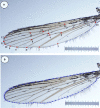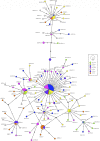Aedes albopictus diversity and relationships in south-western Europe and Brazil by rDNA/mtDNA and phenotypic analyses: ITS-2, a useful marker for spread studies
- PMID: 34174940
- PMCID: PMC8235640
- DOI: 10.1186/s13071-021-04829-9
Aedes albopictus diversity and relationships in south-western Europe and Brazil by rDNA/mtDNA and phenotypic analyses: ITS-2, a useful marker for spread studies
Abstract
Background: Aedes albopictus is a very invasive mosquito, which has recently colonized tropical and temperate regions worldwide. Of concern is its role in the spread of emerging or re-emerging mosquito-borne diseases. Ae. albopictus from south-western Europe and Brazil were studied to infer genetic and phenetic diversity at intra-individual, intra-population and inter-population levels, and to analyse its spread.
Methods: Genotyping was made by rDNA 5.8S-ITS-2 and mtDNA cox1 sequencing to assess haplotype and nucleotide diversity, genetic distances and phylogenetic networks. Male and female phenotyping included combined landmark-and outlined-based geometric morphometrics of wing size and shape.
Results: Specimens from seven populations from Spain, France and Brazil provided 12 cox1 and 162 5.8S-ITS-2 haplotypes, with great genetic variability difference between both markers (0.9% vs 31.2%). Five cox1 haplotypes were shared with other countries, mainly Italy, USA and China, but none was shared between Europe and Brazil. The 5.8S-ITS-2 showed 2-7 intra-individual (mean 4.7) and 16-34 intra-/inter-population haplotypes (24.7), including haplotypes shared between Spain, France and Brazil. A 4.3% of ITS-2 haplotypes were shared, mainly with Italy, USA and Thailand, evidencing worldwide spread and introductions from areas where recent outbreaks of Ae. albopictus-transmitted pathogens occurred. Wing size showed sex differences. Wing shape distinguished between Brazilian and European specimens. Both genetic and morphometric markers showed differences between insular Spain and continental Spain, France and Brazil.
Conclusions: ITS-2 proves to be a useful marker to assess Ae. albopictus spread, providing pronouncedly more information than cox1, including intra-individual, intra-population and inter-population levels, furnishing a complete overview of the evolutionary exchanges followed by this mosquito. Wing morphometry proves to be a useful phenotyping marker, allowing to distinguish different populations at the level of both male and female specimens. Results indicate the need for periodic surveillance monitorings to verify that no Ae. albopictus with high virus transmission capacity is introduced into Europe.
Keywords: Aedes albopictus; Brazil; Cloning; Disease vector; Molecular haplotyping; Sequencing; South-western Europe; Wing geometric morphometry; mtDNA cox1; rDNA 5.8S-ITS-2.
Conflict of interest statement
All the authors have read the manuscript and have approved this submission. All have made substantive contributions to this work. The authors report no conflicts of interest.
Figures







References
-
- World Health Organization—WHO: Vector borne diseases. 2020. https://www.who.int/news-room/fact-sheets/detail/vector-borne-diseases. Accessed 22 Oct 2020.
MeSH terms
Substances
Grants and funding
LinkOut - more resources
Full Text Sources

